SafeManure legislation opens new doors for manure-derived nitrogen fertilisers.
Many European farmers are restricted in the amount of manure they can apply to farmland as a result of legislation to protect water pollution by nitrates. The European Commission is now exploring possibilities to allow manure-derived nitrogen fertilisers to be applied to farmland similar to chemical fertilisers. Specific criteria and conditions for these so-called RENURE (REcycled Nitrogen from manURE) products are currently under development. Here we explain the principles and highlight how this new SafeManure legislation will allow for more flexibility in manure usage on the farm.
How can SafeManure influence farming?
Implementation of SafeManure could indeed be a very interesting development for farmers in Nitrate Vulnerable Zones (NVZ). It would mean that farmers could apply more nitrogen (N) from processed manure and potentially reduce the amount of chemical fertiliser that is currently applied on their farmland.
This is fully in line with the objectives of the Circular Economy Action Plan and creates an opportunity to encourage recycled nutrients that can replace nutrients from primary raw materials like synthetically produced N-fertilisers.
Under the current EU legislation the recycled or derived fertilisers from manure origin are still categorised as ‘manure fertiliser’, with a nitrogen limitation of 170 kg/ha (or 230 to 250 kg/ha under derogation). Under this new proposed legislation, certain manure-derived products would not be categorized as ‘manure fertiliser’ but would fall under the same application rules as chemical fertilisers.
By substituting chemical N-fertilisers with these manure-derived products farmers can apply larger amounts of this N per hectare of farmland, which will subsequently lead to increased flexibility. This can help turn manure – often regarded as a waste product – into a valuable nutrient and seize the full value in a circular economy process.
Criteria and conditions of SafeManure
The intention is that products that meet the SafeManure (or RENURE) criteria are not treated as ‘processed manure’ under the Nitrates Directive but can be applied to crops under similar conditions as chemical fertilisers. The draft criteria for recycled manure products are defined as follows:
- TOC:TN ratio ≤ 3
or
- Mineral N:TN ratio ≥ 90%.
TOC = Total Organic Carbon and TN = Total Nitrogen
Besides these two criteria there are thresholds regarding heavy metals: maximum 300 mg copper, 1 mg mercury and 800 mg zinc per kg dry matter.
The general idea behind it all is that candidate RENURE materials compliant with these criteria can have a similar agronomic efficiency and N leaching potential to Haber-Bosch derived chemical N-fertilisers, assuming they are applied under good management practices. Member countries will most likely need to enforce best management for timing and mode of application as well as storage requirements of RENURE materials to avoid emissions to air and overwinter leaching N losses. Therefore, low emission application will most likely remain a condition to prevent ammonia emissions.
The Nitrates DirectiveThe Nitrates Directive (91/676/EEC) aims at protecting water from diffuse pollution (nitrates and eutrophication) from agricultural activity. To this end, the Directive establishes restrictions on the use of nitrogen-containing fertilising materials in areas with nitrate pollution in waters (Nitrate Vulnerable Zones – NVZ). Manure and manure-based fertilisers are subject to more stringent restrictions than nitrogen-containing mineral/chemical fertilisers. More specifically, in NVZ the Nitrates Directive restricts the use of manure, including processed manure, to 170 kg N/hectare per year. This maximum limit for manure-based fertilising materials in polluted areas is based on the consideration that the associated environmental risk, especially the nitrogen leaching risk, is higher for manure than for other fertilisers. |
Manure processing technologies
Manure processing is mainly applied with the objective of improving manageability and utilisation of livestock manure. Efforts are ongoing across the EU to develop manure processing technologies that allow manure to be turned into a safe and agronomically valuable resource that could be more widely used in NVZs. Examples of manure processing technologies that can potentially produce ‘SafeManure-approved’ RENURE products are:
- Solid/liquid separation through filtration, sieving, centrifuging or decanting
- Liquid/gas separation technologies using stripping and scrubbing of ammonia
- Concentration technologies using evaporation or filtration methods (membranes; reverse osmosis) to produce a mineral concentrate
- Biological transformation using e.g. Anaerobic Digestion
- Nitrogen fixation using plasma treatment
Plasma treatment turns manure into RENURE
N2 Applied’s plasma treatment technology turns manure (slurry) or digestate into an efficient fertiliser that matches the RENURE criteria. Adding more N as nitrates into the slurry or digestate, and therefore increasing the Total-N content, will lower the TOC:TN ratio in most cases to match the ≤ 3 criteria. The process also stabilises the ammonia-N and reduces emissions during storage and field application.
Especially for digestate – with a pH of 7 to 8 and relatively high ammonia-N levels compared to slurry – the plasma treatment provides a valuable solution that ensures low emission field application. Avoiding these emissions and matching the performance of chemical fertilisers makes the Nitrogen Enriched Organic fertiliser (NEO) – the resultant product from plasma treatment – extremely suitable as a RENURE product under SafeManure criteria. A new era in manure management has started!





